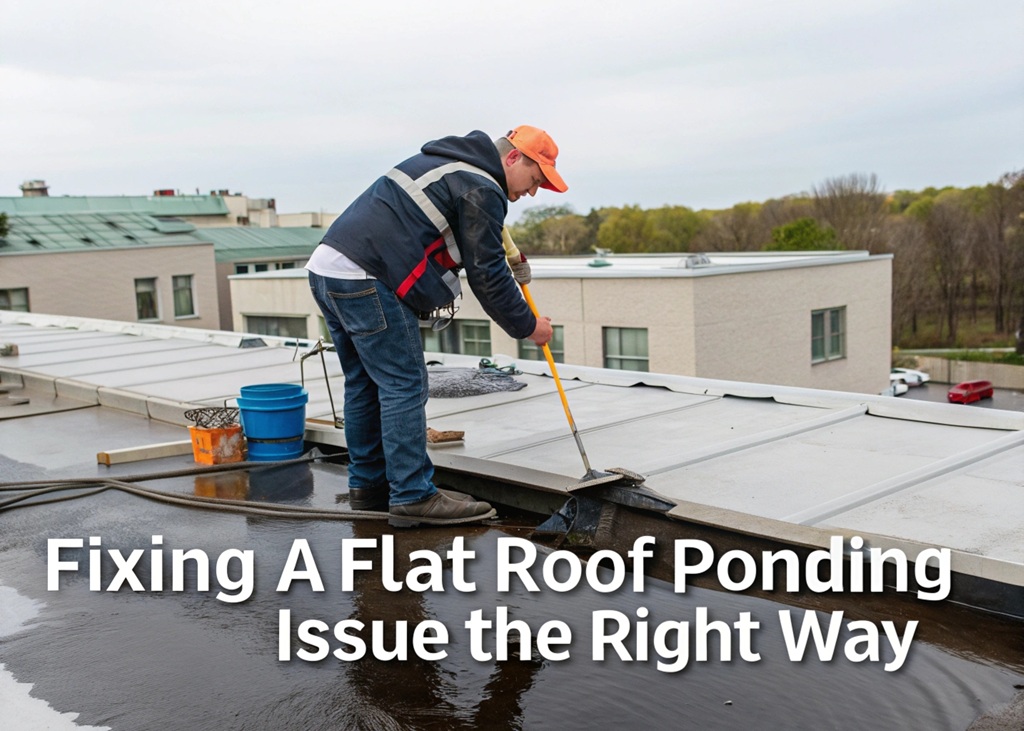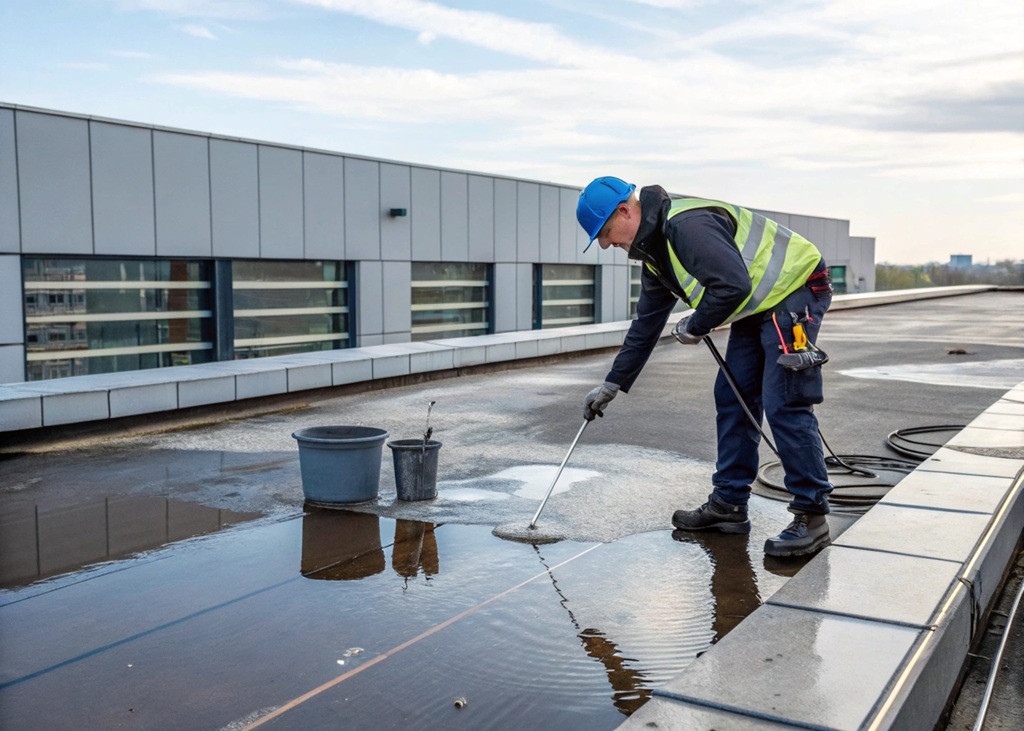Stop Roof Ponding Fast: Fixing a Flat Roof Ponding Issue the Right Way

Flat roofs are popular for their clean lines and modern appeal. However, they often come with one persistent problem—ponding water. This is when water collects in low spots and doesn’t drain off within 48 hours after rainfall. Over time, this standing water can cause serious damage.
If left untreated, ponding weakens the roof’s surface, leading to leaks, mold growth, and even structural damage. According to a report by the National Roofing Contractors Association (NRCA), water ponding is a top cause of early roof failure. Worse, insurance claims for roof damage due to neglect are often denied.
I learned this the hard way when ponding water on my garage roof led to interior water stains and a moldy smell that took months to fix. If I had acted sooner, I would’ve saved thousands.
In this guide, we’ll show you the best ways to spot, fix, and prevent ponding on your flat roof. Whether you’re a homeowner or a contractor, these tips are practical and proven.
If you’re short on time or want expert help, explore Roof Master Construction for professional solutions.
What Causes Ponding Water on a Flat Roof?

Before you can fix the issue, you need to know why it’s happening. Ponding water doesn’t just show up without a reason. Most of the time, it’s caused by poor drainage or an uneven roof surface.
Common causes include:
- Clogged Drains or Gutters – Leaves, dirt, or roofing material can block drainage paths.
- Improper Roof Slope – A flat roof should have at least a 1/4 inch slope per foot to ensure water drains.
- Compressed Insulation – Over time, insulation under the roofing membrane can sink due to weight and moisture.
- Roof Design Flaws – Older flat roofs often lack proper design for water movement.
- Heavy Snow or Rain Accumulation – Sudden storms can overwhelm your roof if it’s not properly maintained.
The International Building Code (IBC) recommends a slope of ¼ inch per foot to avoid water buildup. If your roof doesn’t meet this standard, ponding is almost guaranteed.
So, start with an inspection after rain. Look for puddles that last more than two days. These are your warning signs. In the middle of a repair process, I also had to discover how to repair shingles at https://roofmasterconstruction.com/roofing-repairs/how-to-repair-roof-shingles/ as part of restoring a damaged section next to the flat roof.
How to Identify Ponding Areas Before It’s Too Late
Spotting the issue early can save you a lot of trouble. Water may not be visible if it’s evaporating fast, so you need to inspect your roof regularly.
Here’s how to identify ponding zones:
- Check after rainfall – Look 24 to 48 hours later. Are there still puddles?
- Look for roof staining – Water often leaves a dirt ring or algae stains.
- Feel for soft spots – These could mean moisture has penetrated layers beneath the surface.
- Use a level – Place it across areas that look sunken to measure depressions.
- Check inside – Are there ceiling stains or moldy smells? These point to trapped moisture.
You should also take photos of ponding for documentation. This helps when explaining issues to a roofer or filing insurance claims.
If you’re unsure what to look for, many roofing companies offer free inspections. Early detection is the first step to protecting your investment.
5 Proven Ways to Fix Flat Roof Ponding Issues
Once you’ve identified the problem areas, it’s time to fix them. Below are five reliable methods to stop water from pooling and keep your flat roof dry.
1. Improve Roof Drainage
- Install scuppers, gutters, or downspouts to channel water off the roof.
- Use crickets or tapered insulation to guide water toward the drains.
- Ensure all drain points are clear of debris regularly.
2. Add Tapered Insulation
- A great long-term fix.
- Tapered insulation can reshape your roof’s slope to promote water runoff.
- It’s especially effective for older roofs without proper pitch.
3. Recoat with Waterproof Sealant
- Use high-quality elastomeric coatings to seal your flat roof.
- These products can handle minor depressions and extend your roof’s life.
- Best for short-term fixes or budget solutions.
4. Install a Roof Cradle System
- A cradle lifts mechanical units or heavy objects off the roof surface.
- It reduces pressure that compresses insulation, stopping low spots from forming.
5. Full Roof Replacement (When Necessary)
- If ponding is widespread, a new roof may be the only way to go.
- Choose materials like PVC, TPO, or modified bitumen, which have better drainage properties.
Choose your fix based on how bad the ponding is and your roof’s age. Always consult a professional if unsure.
When to Call a Roofing Expert
DIY works for simple drainage cleaning or sealing minor dips. But when structural damage is involved, don’t go it alone.
Call a pro if:
- You see multiple areas of ponding.
- There’s leakage into your home’s interior.
- You suspect insulation damage or structural sagging.
- Your flat roof is over 15 years old.
Roofers can use infrared cameras to detect trapped moisture. They can also evaluate slope, inspect membrane integrity, and suggest the best solution.
Additionally, professional fixes often come with warranties. That alone can give you peace of mind.
According to Roofing Contractor Magazine, over 70% of commercial roofs with ponding issues develop leaks within 5 years if not properly repaired. Don’t wait that long.
How to Prevent Future Ponding on Your Flat Roof
Prevention is the best cure. If you’ve dealt with ponding once, chances are it’ll happen again unless you make changes.
Follow these easy prevention tips:
- Schedule regular roof inspections—ideally twice a year.
- Clear gutters and drains after every major storm.
- Limit rooftop equipment weight or support it with cradles.
- Apply a protective coating every few years.
- Check slope and drainage after roof repairs or modifications.
A well-maintained flat roof can last up to 25 years, but only if you catch and fix issues like ponding early.
If you’re considering new construction or a replacement, work with experienced contractors who understand the slope and drainage needs of flat roofs. It saves time, money, and stress later.
Read More Also: Top 5 Reasons to Design Your Home in 3D Before Breaking Ground
Conclusion
Ponding on a flat roof is more than a cosmetic problem. It’s a real threat to your home’s safety and your wallet. Luckily, once you know what to look for—and what to do—you can take control.
From clearing your drains to adding slope with tapered insulation, the solutions are clear and effective. And if you ever feel overwhelmed, professionals are just a call away.
Remember, water is silent but destructive. Don’t let ponding be the reason your roof fails.
If you’ve found this guide helpful, leave a comment below and share it with a friend who might need it too.
Read More Also: How to Install Carpet on Stairs: A Step-by-Step Guide
FAQs
### What is roof ponding?
Roof ponding is when water remains on a flat roof for more than 48 hours after rainfall. It can damage roofing materials and lead to leaks.
### Can ponding water cause roof leaks?
Yes. Over time, standing water can wear through protective coatings and membranes, leading to leaks and mold inside.
### How much slope should a flat roof have?
Flat roofs should have a minimum slope of 1/4 inch per foot to ensure proper drainage and prevent ponding.
### Can I fix roof ponding myself?
You can fix minor issues like clogged drains or apply sealants. But for structural problems, it’s best to hire a professional roofer.
### How do I prevent ponding in the future?
Regular inspections, drain cleaning, and adding slope with tapered insulation are effective ways to stop ponding from coming back.






